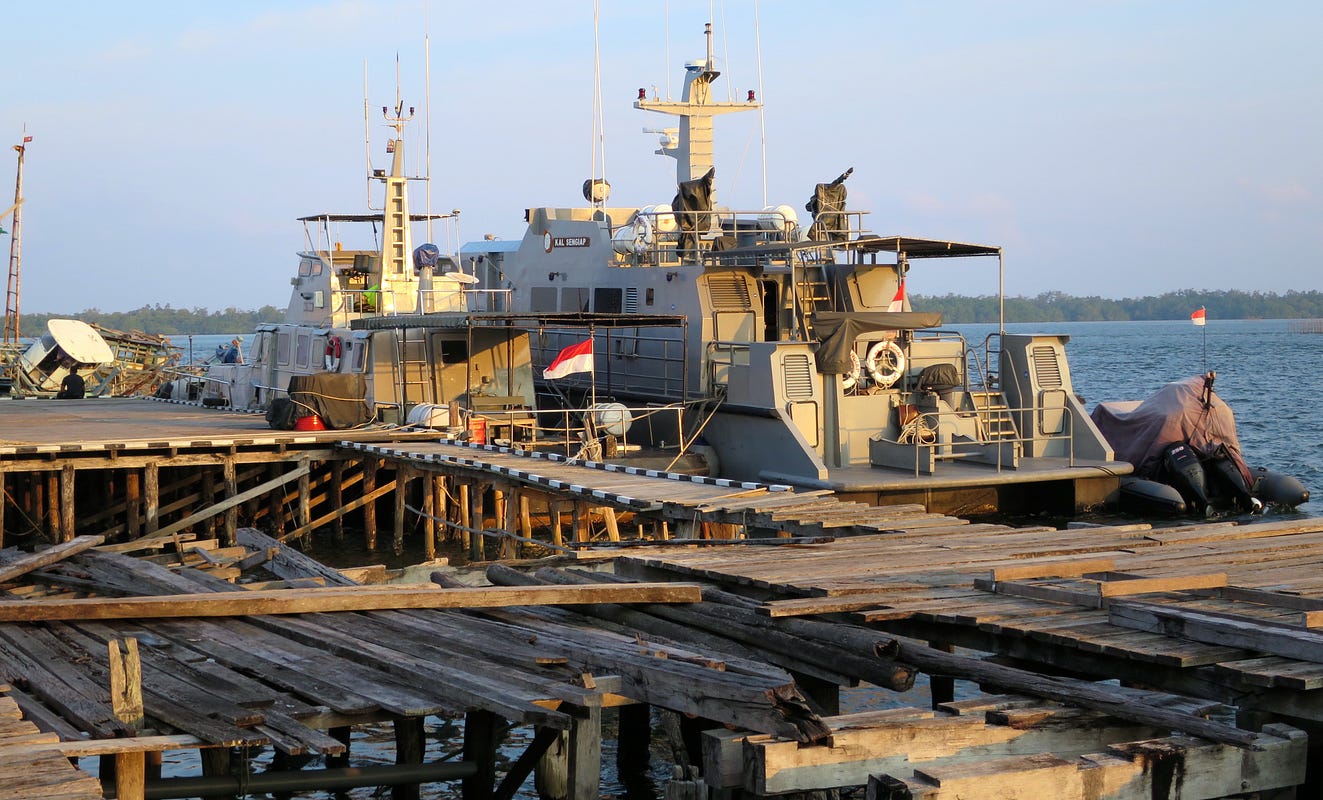
Jakarta (MI) : What might be called
“homeland security” is tight at Natuna Island, and it should be — this
may be the next bite China takes out of the South China Sea.
Upon
landing at Natuna (also called Natuna Besar), Indonesia’s largest
island within the hotly contested South China Sea, foreigners must
register and provide copies of their passports even though all arriving
flights are domestic. No photos are allowed until well outside the
airfield because it doubles as an Indonesian Air Force base. When
departing the island, all foreigners must “check out” with security
personnel who quiz visitors on where they have been during their stay,
and their routing into and out of the area. Even a casually met off-duty
naval officer will make pointed inquiries about a visitor’s activities
on the island.

Two of three air force hangars at Natuna’s Ranai airfield. Photo by Victor Robert Lee.
Given that Beijing has recently promulgated a map with boundaries that
claim a swath of sea that may include the Natuna Islands as part of its
territory, the increased security is understandable, but the paucity of
military clout on this significant Indonesian border outpost is a stark
reminder that Beijing faces little hard resistance to its ongoing
annexation of the South China Sea. Over the past two years, China has
reinforced its territorial quest through intimidation, naval patrols,
localized blockades, oil rig placements, ramming of fishing vessels, and
construction of military facilities on numerous small islands and
sub-surface shoals.

How
to connect Beijing’s speculative dashes? The 2013 map is by SinoMaps
Press, an arm of the Chinese government (with thanks to Euan Graham for a
digital image). Dashes in pink denote Beijing’s claimed “nine-dashed
line” (now comprising ten dashes). Superimposed black dashed lines, by
the author, show hypothetical ways of connecting the two southernmost
dashes in Beijing’s self-proclaimed southern boundary. All three
hypotheticals would overlap with Indonesia’s claimed territory around
the Natuna Islands, including the reportedly largest gas field in
Southeast Asia, called Natuna D Alpha block, recently renamed Natuna
East field, which has been the subject of longstanding dealings between
the Indonesian government and Exxon Mobil Corporation. Repeated requests
to ExxonMobil to clarify the contractual status of the Natuna East
field and the potential impact of China’s claims on the territory were
not answered.
Until
recently Indonesia seemed immune to these hostilities, and its
government offered itself as an honest broker among the disputing
neighboring states — China, Vietnam, the Philippines, Malaysia, Brunei,
Taiwan — but with Beijing’s recent inclusion of the area around Natuna
in its newly sanctioned maps (and on Chinese passports), Indonesia’s
incoming President Joko Widodo may find China’s aggression to be a first
item in his inbox when he assumes office on October 20th.
He
will also find that the air force base at Natuna as well as the “naval
base” there are unlikely to provide much front-line defense. The air
force base has an abundance of housing quarters — more than thirty small
buildings — but only three modest aircraft hangars. The fact that there
are no military aircraft visible at the base may demonstrate stealth,
or perhaps the absence of aircraft.

Indonesian naval vessels at dock, Natuna Island. Photo by Victor Robert Lee.
On the lawn of an adjacent navy compound, two dozen personnel including
several women were admirably practicing martial arts, but the only navy
vessels on the island are two small and lightly armed patrol boats and
an RIB (rigid inflatable boat), all tied to a deteriorating pier. Even
granting that some naval assets may have been transferred recently to a
base in the Anambas Islands, 210 miles to the southwest of Natuna, the
strict no-photo regulation may be driven by a wish to hide weaknesses
rather than to keep military secrets.

The primary radar station on Natuna Island for monitoring the South China Sea. Photo by Victor Robert Lee.
In March of this year Indonesia’s
government for the first time acknowledged that China’s unilateral
claims on most of the South China Sea include parts of Indonesia’s Riau
province, to which Natuna and other islands belong. Indonesia, a nation
of 250 million people, may, despite its government’s polite attempts to
carve itself out of the South China Sea conflicts, find itself the
latest victim of Beijing’s acquisition campaign.
In March 2013, as researcher Scott Bentley has described,
a Chinese “maritime law enforcement” ship confronted an Indonesian
patrol vessel that had arrested nine Chinese fishermen for operating in
Indonesia’s exclusive economic zone, 200 kilometers northeast of Natuna
Island. The commander of the armed Chinese vessel Yuzheng 310 threatened
the Indonesian crew and demanded the release of the Chinese detainees.
It is also highly likely that the Yuzheng 310 electronically jammed the
communications of the Indonesian boat. Under threat and with no link to
headquarters, the Indonesians released the Chinese fishermen. There is
evidence that other similar incidents have occurred, but the Indonesian
government has refrained from discussing them in public.
Sumber : Medium

Lakukan Usaha Diplomatik, Serta Perkuat pertahan di garda depan kepulauan indonesia baik pasukan dan alutsista siapkan bahan bakar kendaraan tempur untuk 3 bulan kedepan...sisipkan inteligent ke china.. sisipkan pasukan2 khusus pengahancur daerah strategis di china.. sispkan pasukan untuk mematikan Mental2 pasukan mereka.... saya yakin TNI telah melakukan hal tersebut... jayalah TNI
ReplyDelete